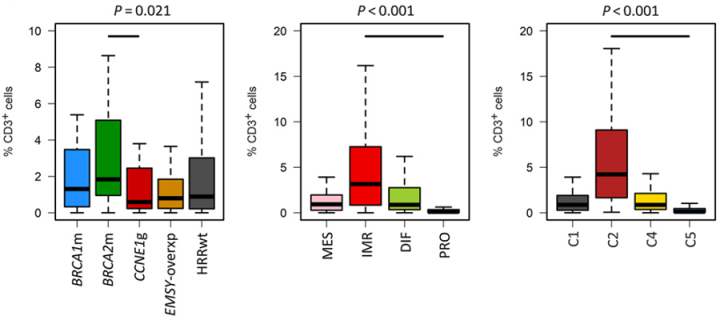Multiomic characterization of high-grade serous ovarian carcinoma enables high-resolution patient stratification
Edinburgh led study provides high-resolution picture of the molecular landscape in high-grade serous ovarian carcinoma, better defining patients who may benefit most from specific molecular therapeutics and highlighting those for whom novel treatment strategies are needed to improve outcomes: July 2022

In the UK nearly 7500 people are diagnosed with ovarian cancer every year and high-grade serous ovarian carcinoma (HGSOC) represents its most common form, accounting for approximately 70-80% of ovarian cancer deaths. The majority of patients with HGSOC are diagnosed at advanced stage and experience poor prognosis, with five-year survival of only about 30% in this population.
There is an urgent need for better outcomes. Many scientists believe that this could be achieved by identifying therapeutically exploitable aspects of the disease biology, which could lead to better patient stratification for therapy and development of more effective treatments. To this end, investigators in Edinburgh have a well established ovarian cancer research programme that has already delivered significant developments for various types of ovarian cancer and, over the years, contributed to introduction and approvals of new ovarian cancer treatments that are now available to patients.
In a recent study, titled “Multiomic characterization of high-grade serous ovarian carcinoma enables high-resolution patient stratification”, they used data derived from a large cohort of HGSOC patients that had been treated at the Edinburgh Cancer Centre to provide important new insights into the relationship between therapy sensitivity/outcomes and diverse biological characteristics of HGSOC tumours. They present matched characterization at genomic (DNA sequence and gene copy number) and transcriptomic (RNA transcripts that are produced by the genome) levels combined with additional molecular features, including immune cell infiltration and loss of expression of tumour suppressor proteins RB and PTEN characterised by using immunohistochemistry methods. The work highlights several points that are likely to lead to improvements in future patient stratification and rational trial design of HGSOC therapeutics. Importantly, the work identifies patients with amplification of CCNE1 gene (a gene encoding for protein known as Cyclin E1) but without alterations in HRR DNA repair genes (HRR genes are genes involved in a process known as homologous recombination DNA repair and include BRCA1 and BRCA2 genes among others) as those with greatest unmet clinical need, suggesting that investigations of new treatment strategies for this patient group should be prioritised. It also demonstrates that, contrary to previous beliefs, RB and PTEN loss are frequent events in HGSOC and often occur alongside other molecular events, with RB loss affecting a large number of tumours with HRR gene aberrations.
The study was published in the journal Clinical Cancer Research. It was led by Edinburgh Cancer Research investigators within the Institute of Genetics and Cancer as part of the Nicola Murray Centre for Ovarian Cancer Research and the CRUK Scotland Centre activities.
This work provides multilayer characterization of high-grade serous ovarian carcinoma. We believe that our study demonstrates that the concept of a simple model where each HGSOC in a patient cohort is ascribed to a key driver event is outdated and that for many tumours multiple key events may coexist and may independently affect outcome and therapy response.
Related Links
Article in Clinical Cancer Research:
https://aacrjournals.org/clincancerres/article/doi/10.1158/1078-0432.CCR-22-0368
Professor Charlie Gourley group website:
https://www.ed.ac.uk/cancer-centre/research/gourley-group
Professor Simon Herrington group website:
https://www.ed.ac.uk/cancer-centre/research/herrington-group
Information about ovarian cancer:
https://www.cancerresearchuk.org/about-cancer/ovarian-cancer
Related Stories
- Trametinib as a new standard of care option for low-grade serous ovarian cancer
- Opportunities for stratification in endometrioid ovarian carcinoma
- Molecular stratification of endometrioid ovarian carcinoma predicts clinical outcome
- Olaparib approved in Scotland as new ovarian cancer treatment
- Drug trial offers hope of improved ovarian cancer treatments
- Ovarian cancer drug delays relapse

